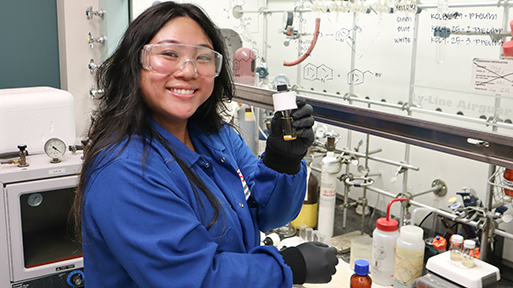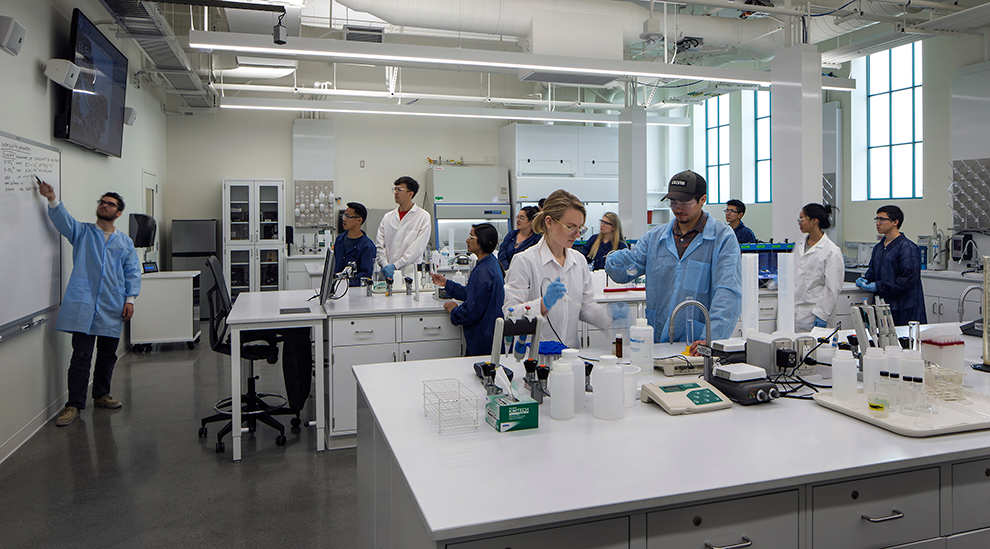Channeling Sunlight to Create Indoor Lighting Energy Sources
Mechanical engineer Sung-Yong (Sean) Park is the latest at SDSU to earn an NSF CAREER grant for his work on sustainable energy.

As the largest source of energy consumption in the U.S., commercial buildings are in need of an environmentally friendly alternative. That’s where Sung-Yong (Sean) Park’s research comes in.
A mechanical engineering professor in the College of Engineering, Park studies the intersection of the light and the behavior of fluids through small channels for energy systems, called optofluidics, which enable technologies such as solar energy. The scope of his current research centers on creating sustainable energy sources, such as solar indoor lighting.
This past spring, Park received a highly selective National Science Foundation CAREER Award to continue his work. CAREER grant recipients are early career faculty members selected for their potential as academic role models in research and education and to lead advances in the mission of their institution.
Park, who runs the Optofluidic Bio & Energy Systems (OBES) laboratory on campus, is the third CAREER Award recipient from the College of Engineering this year, along with electrical and computer engineer Junfei Xie and construction engineer Reza Akhavian.
“We are delighted to support Sean Park's creative work in the scientifically and technologically important area of optofluidic lighting research,” said Eugene Olevsky, dean of the College of Engineering. “Our college is rapidly growing its research activities. Almost 60% of our faculty members are new research-oriented professors who have been hired during the last six years.”
Park’s CAREER grant provides $500,000 in funding over five years from the National Science Foundation (NSF) to develop a novel optofluidic lighting approach that uses rooftop solar energy and excess sunlight to illuminate the inside of commercial buildings.
This will allow for active control of lighting brightness and power, regardless of the current power of the sun, said Park. “As society has developed, electric lighting has rapidly become one-third of buildings’ energy consumption, so why not use the sunlight — especially in California where the sun is very strong — for indoor lighting?”
Though solar lighting is not a novelty, the current model for solar-powered indoor lighting involves many unnecessary conversions, said Park. “The solar cell method turns sunlight into electricity, and then electricity can be converted into lighting. There are so many conversions that ultimately only 4% of the natural sunlight can be used.”
Optofluidic benefits
Park’s optofluidic method allows for more sunlight to be directly used for indoor buildings, and for the user to have control of the brightness level and power status of the lighting.
With the building sector accounting for more than 70% of all U.S. electricity use and 40% of total U.S. energy consumption, the solar-powered lighting initiative will support the NSF’s commitment to positive societal impact and solve energy issues due to the need for more sustainable and environmentally friendly buildings.
Aside from the positive psychological benefits of lighting that fascinate Park, such as increased productivity and increased mood/energy levels, he said the funding will allow the project to be a light, no pun intended, for the community. The NSF funding will also make a positive local impact possible through outreach activities that will be conducted with the goal of promoting participation of underrepresented groups in STEM disciplines.
Next steps for Park’s optofluidic method include future use of optofluidic lighting for indoor solar activities and underground structures, such as subways and underground tunnels, and even indoor farming.
Long before electricity, societies relied on natural sunlight to provide indoor lighting. Since then, we have relied on electric energy-heavy indoor lighting sources to illuminate our workplaces and homes — all while the sunlight remains just as useful and bright.
This raises the question: can we channel this sunlight to reduce global energy consumption? Park is going to find out.



